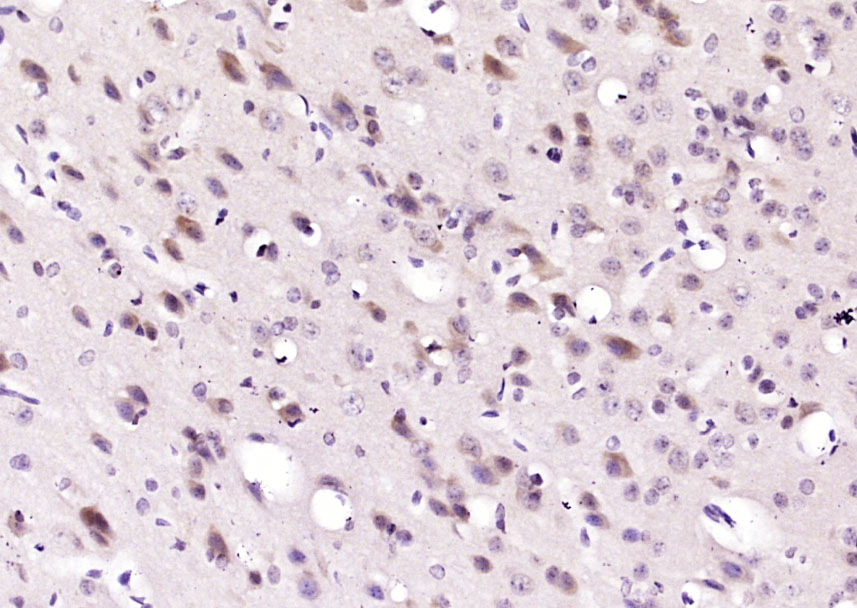
Rabbit Anti-AKR1C3 antibody
17 beta HSD 5; 17 beta hydroxysteroid dehydrogenase type 5; 17-beta-HSD 5; 17-beta-hydroxysteroid dehydrogenase type 5; 2-dihydrobenzene-1; 2-diol dehydrogenase; 3 alpha hydroxysteroid dehydrogenase type II; 3-alpha-HSD type 2; 3-alpha-HSD type II; 3-alph
View History [Clear]
Details
Product Name AKR1C3 Chinese Name 醛固酮还原酶家族1成员C3抗体 Alias 17 beta HSD 5; 17 beta hydroxysteroid dehydrogenase type 5; 17-beta-HSD 5; 17-beta-hydroxysteroid dehydrogenase type 5; 2-dihydrobenzene-1; 2-diol dehydrogenase; 3 alpha hydroxysteroid dehydrogenase type II; 3-alpha-HSD type 2; 3-alpha-HSD type II; 3-alpha-HSD type II, brain; 3-alpha-hydroxysteroid dehydrogenase type 2; AK1C3_HUMAN; AKR1 C3; AKR1C3; Aldo keto reductase family 1 member C3; Aldo-keto reductase family 1 member C3; brain; Chlordecone reductase; Chlordecone reductase homolog HAKRb; DD-3; DD3; DDH1; DDX; Dihydrodiol dehydrogenase 3; Dihydrodiol dehydrogenase type I; Dihydrodiol dehydrogenase X; HA1753; HAKRB; HAKRe; hluPGFS; HSD17B5; Indanol dehydrogenase; KIAA0119; PGFS; Prostaglandin F synthase; Testosterone 17-beta-dehydrogenase 5; Trans-1; Trans-1,2-dihydrobenzene-1,2-diol dehydrogenase; Type IIb 3 alpha hydroxysteroid dehydrogenase. Research Area Tumour Cell biology Neurobiology Signal transduction Endocrinopathy Immunogen Species Rabbit Clonality Polyclonal React Species Rabbit, (predicted: Human, Dog, Pig, Cow, Horse, ) Applications WB=1:500-2000 ELISA=1:5000-10000 IHC-P=1:100-500 IHC-F=1:100-500 ICC=1:100-500 IF=1:100-500 (Paraffin sections need antigen repair)
not yet tested in other applications.
optimal dilutions/concentrations should be determined by the end user.Theoretical molecular weight 36kDa Cellular localization cytoplasmic Form Liquid Concentration 1mg/ml immunogen KLH conjugated synthetic peptide derived from human AKR1C3: 161-270/323 Lsotype IgG Purification affinity purified by Protein A Buffer Solution 0.01M TBS(pH7.4) with 1% BSA, 0.03% Proclin300 and 50% Glycerol. Storage Shipped at 4℃. Store at -20 °C for one year. Avoid repeated freeze/thaw cycles. Attention This product as supplied is intended for research use only, not for use in human, therapeutic or diagnostic applications. PubMed PubMed Product Detail DD3 is a unique enzyme that can specifically catalyze the dehydrogenation of trans-benzenedihydrodiol and trans-naphthalenedihydrodiol. Human liver contains isoforms of dihydrodiol dehydrogenase (DD1, DD2, DD3 and DD4), which belong to the aldo-oxo reductase/aldo-keto reductase (AKR) superfamily, have 20Alpha- or 3Alpha-hydroxysteroid dehydrogenase (HSD) activity. DD1 is also designated AKR1C1, DDH or DDH1 while DD2 also can be designated AKR1C2, dDD, BABP or DDH2. AKR1C3 and 3Alpha-HSD are alternate designations for DD3, while DD4 also can be called AKR1C4, CD or CHDR. DD1 and DD2 are 20Alpha-HSDs, whereas DD3 and DD4 are the 3Alpha-HSDs. The multiple human cytosolic dihydrodiol dehydrogenases are involved in the metabolism of xenobiotics, such as polycyclic aromatic hydrocarbons, pesticides and steroid hormones, and are responsible for the reduction of ketone-containing drugs by using NADH or NADPH as a cofactor. The 20Alpha-HSD catalyzes the reaction of progesterone to the inactive form 20Alpha-hydroxyprogesterone. The 3Alpha-HSD is a cytosolic, monomeric, NADPH-dependent oxidoreductase that reduces 3-keto-5-dihydrosteroids to their tetrahydro products. DD1 and DD2 are ubiquitously expressed, whereas DD4 mRNA is restricted to the liver.
Function:
Catalyzes the conversion of aldehydes and ketones to alcohols. Catalyzes the reduction of prostaglandin (PG) D2, PGH2 and phenanthrenequinone (PQ) and the oxidation of 9-alpha,11-beta-PGF2 to PGD2. Functions as a bi-directional 3-alpha-, 17-beta- and 20-alpha HSD. Can interconvert active androgens, estrogens and progestins with their cognate inactive metabolites. Preferentially transforms androstenedione (4-dione) to testosterone.
Subcellular Location:
Cytoplasm.
Tissue Specificity:
Expressed in many tissues including adrenal gland, brain, kidney, liver, lung, mammary gland, placenta, small intestine, colon, spleen, prostate and testis. The dominant HSD in prostate and mammary gland. In the prostate, higher levels in epithelial cells than in stromal cells. In the brain, expressed in medulla, spinal cord, frontotemporal lobes, thalamus, subthalamic nuclei and amygdala. Weaker expression in the hippocampus, substantia nigra and caudate.
Similarity:
Belongs to the aldo/keto reductase family.
SWISS:
P42330
Gene ID:
8644
Database links:Entrez Gene: 8644 Human
Omim: 603966 Human
SwissProt: P42330 Human
Unigene: 78183 Human
Product Picture
Bought notes(bought amounts latest0)
No one bought this product
User Comment(Total0User Comment Num)
- No comment



 +86 571 56623320
+86 571 56623320
 +86 18668110335
+86 18668110335

